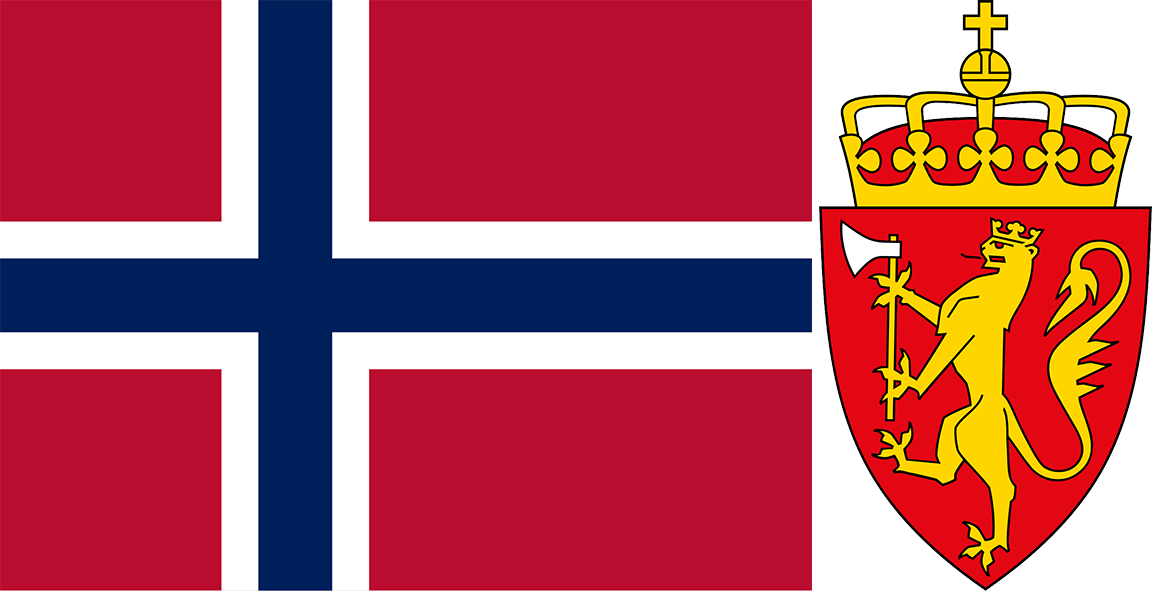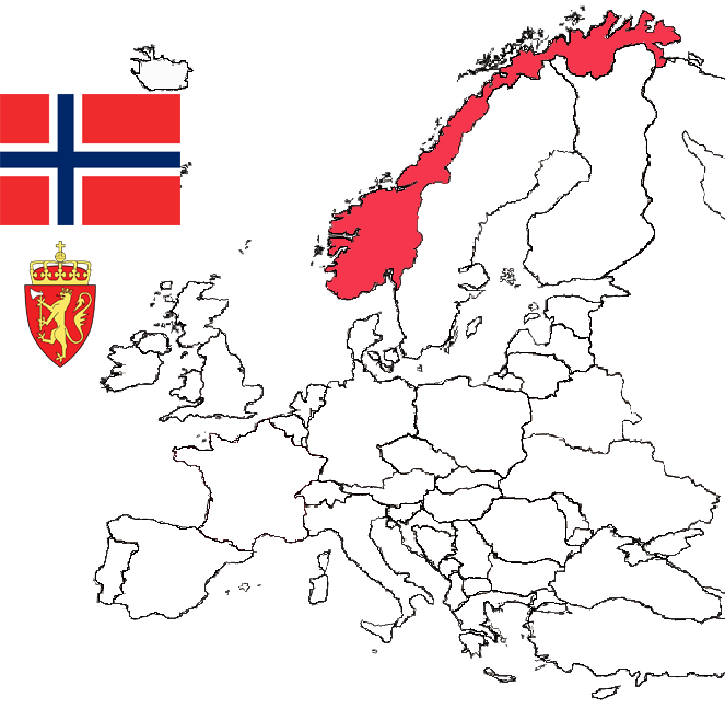FabulousFusionFood's Norwegian Recipes Home Page
 The flag of Norway (left) and the coat of arms of Norway (right).
The flag of Norway (left) and the coat of arms of Norway (right).
Welcome to the summary page for FabulousFusionFood's Norwegian recipes, part of Europe. This page provides links to all the Norwegian recipes presented on this site, with 4 recipes in total.
This is a continuation of an entire series of pages that will, I hope, allow my visitors to better navigate this site. As well as displaying recipes by name, country and region of origin I am now planning a whole series of pages where recipes can be located by meal type and main ingredient. This page gives a listing of all the Indian recipes added to this site.
Norway, officially: Kongeriket Norge (Bokmål) and Kongeriket Noreg (Nynorsk) (Kingdom of Norway) is a constitutional monarchy in Northern Europe that occupies the western portion of the Scandinavian Peninsula. Norway also includes the Arctic island territories of Svalbard and Jan Mayen. The capital and largest city is Oslo and Norwegian is the official language (though two official written forms, Bokmål and Nynorsk).
Like neighbouring Sweden, the traditional cookery of Norway is fairly simple, based around the staples of fish, meat and potatoes. Spices (which had to be sourced from the Mediterranean) were scarce. Stews based on meat and vegetables are common as are a range of fish dishes (particularly using dried and pickled fish). Rolled and pickled meats are also a feature of Norwegian cookery.
Norway, (Bokmål: Norge, Nynorsk: Noreg), officially the Kingdom of Norway, is a Nordic country in Northern Europe, situated on the Scandinavian Peninsula with a population of 5.5 million as of 2024. The remote Arctic island of Jan Mayen and the archipelago of Svalbard also form part of Norway. Bouvet Island, located in the Subantarctic, is a dependency; Norway also claims the Antarctic territories of Peter I Island and Queen Maud Land. The capital and largest city in Norway is Oslo.
 Location of Norway in Europe with the land mass of Norway picked out in red.Norway has a total area of 385,207 square kilometres (148,729 sq mi). The country shares a long eastern border with Sweden, and is bordered by Finland and Russia to the northeast. Norway has an extensive coastline facing the Skagerrak strait, the North Atlantic Ocean, and the Barents Sea. Harald V of the House of Glücksburg is the current King of Norway. Jonas Gahr Støre has been Prime Minister of Norway since 2021. As a unitary state with a constitutional monarchy, Norway divides state power between the parliament, the cabinet, and the supreme court, as determined by the 1814 constitution. The unified kingdom of Norway was established in 872 as a merger of petty kingdoms and has existed continuously for 1,151–1,152 years. From 1537 to 1814, Norway was part of Denmark–Norway, and, from 1814 to 1905, it was in a personal union with Sweden. Norway was neutral during the First World War, and in the Second World War until April 1940 when it was invaded and occupied by Nazi Germany until the end of the war.
Location of Norway in Europe with the land mass of Norway picked out in red.Norway has a total area of 385,207 square kilometres (148,729 sq mi). The country shares a long eastern border with Sweden, and is bordered by Finland and Russia to the northeast. Norway has an extensive coastline facing the Skagerrak strait, the North Atlantic Ocean, and the Barents Sea. Harald V of the House of Glücksburg is the current King of Norway. Jonas Gahr Støre has been Prime Minister of Norway since 2021. As a unitary state with a constitutional monarchy, Norway divides state power between the parliament, the cabinet, and the supreme court, as determined by the 1814 constitution. The unified kingdom of Norway was established in 872 as a merger of petty kingdoms and has existed continuously for 1,151–1,152 years. From 1537 to 1814, Norway was part of Denmark–Norway, and, from 1814 to 1905, it was in a personal union with Sweden. Norway was neutral during the First World War, and in the Second World War until April 1940 when it was invaded and occupied by Nazi Germany until the end of the war.
Norway has both administrative and political subdivisions on two levels: counties and municipalities. The Sámi people have a certain amount of self-determination and influence over traditional territories through the Sámi Parliament and the Finnmark Act. Norway maintains close ties with the European Union and the United States. Norway is a founding member of the United Nations, NATO, the European Free Trade Association, the Council of Europe, the Antarctic Treaty, and the Nordic Council; a member of the European Economic Area, the WTO, and the OECD; and a part of the Schengen Area. The Norwegian dialects share mutual intelligibility with Danish and Swedish.
Etymology: Norway has two official names: Norge in Bokmål and Noreg in Nynorsk. The English name Norway comes from the Old English word Norþweg mentioned in 880, meaning 'northern way' or 'way leading to the north', which is how the Anglo-Saxons referred to the coastline of Atlantic Norway. The Anglo-Saxons of Britain also referred to the kingdom of Norway in 880 as Norðmanna land.
There is some disagreement about whether the native name of Norway originally had the same etymology as the English form. According to the traditional dominant view, the first component was originally norðr, a cognate of English north, so the full name was Norðr vegr, 'the way northwards', referring to the sailing route along the Norwegian coast, and contrasting with suðrvegar 'southern way' (from Old Norse suðr) for (Germany), and austrvegr 'eastern way' (from austr) for the Baltic.
Lefse is a Norwegian potato flatbread, usually topped with large amounts of butter and sugar, most commonly eaten around Christmas. Traditional Norwegian dishes include lutefisk, smalahove, pinnekjøtt, raspeball, and fårikål. A Norwegian speciality is rakefisk, which is fermented trout, consumed with thin flatbread and sour cream. The most popular pastry is vaffel.
This is a continuation of an entire series of pages that will, I hope, allow my visitors to better navigate this site. As well as displaying recipes by name, country and region of origin I am now planning a whole series of pages where recipes can be located by meal type and main ingredient. This page gives a listing of all the Indian recipes added to this site.
Norway, officially: Kongeriket Norge (Bokmål) and Kongeriket Noreg (Nynorsk) (Kingdom of Norway) is a constitutional monarchy in Northern Europe that occupies the western portion of the Scandinavian Peninsula. Norway also includes the Arctic island territories of Svalbard and Jan Mayen. The capital and largest city is Oslo and Norwegian is the official language (though two official written forms, Bokmål and Nynorsk).
Like neighbouring Sweden, the traditional cookery of Norway is fairly simple, based around the staples of fish, meat and potatoes. Spices (which had to be sourced from the Mediterranean) were scarce. Stews based on meat and vegetables are common as are a range of fish dishes (particularly using dried and pickled fish). Rolled and pickled meats are also a feature of Norwegian cookery.
Norway, (Bokmål: Norge, Nynorsk: Noreg), officially the Kingdom of Norway, is a Nordic country in Northern Europe, situated on the Scandinavian Peninsula with a population of 5.5 million as of 2024. The remote Arctic island of Jan Mayen and the archipelago of Svalbard also form part of Norway. Bouvet Island, located in the Subantarctic, is a dependency; Norway also claims the Antarctic territories of Peter I Island and Queen Maud Land. The capital and largest city in Norway is Oslo.
 Location of Norway in Europe with the land mass of Norway picked out in red.
Location of Norway in Europe with the land mass of Norway picked out in red.Norway has both administrative and political subdivisions on two levels: counties and municipalities. The Sámi people have a certain amount of self-determination and influence over traditional territories through the Sámi Parliament and the Finnmark Act. Norway maintains close ties with the European Union and the United States. Norway is a founding member of the United Nations, NATO, the European Free Trade Association, the Council of Europe, the Antarctic Treaty, and the Nordic Council; a member of the European Economic Area, the WTO, and the OECD; and a part of the Schengen Area. The Norwegian dialects share mutual intelligibility with Danish and Swedish.
Etymology: Norway has two official names: Norge in Bokmål and Noreg in Nynorsk. The English name Norway comes from the Old English word Norþweg mentioned in 880, meaning 'northern way' or 'way leading to the north', which is how the Anglo-Saxons referred to the coastline of Atlantic Norway. The Anglo-Saxons of Britain also referred to the kingdom of Norway in 880 as Norðmanna land.
There is some disagreement about whether the native name of Norway originally had the same etymology as the English form. According to the traditional dominant view, the first component was originally norðr, a cognate of English north, so the full name was Norðr vegr, 'the way northwards', referring to the sailing route along the Norwegian coast, and contrasting with suðrvegar 'southern way' (from Old Norse suðr) for (Germany), and austrvegr 'eastern way' (from austr) for the Baltic.
Food and Cuisine:
Norway's culinary traditions show the influence of long seafaring and farming traditions, with salmon (fresh and cured), herring (pickled or marinated), trout, codfish, and other seafood, balanced by cheeses (such as brunost, Jarlsberg cheese, and gamalost), dairy products, and breads (predominantly dark/darker).Lefse is a Norwegian potato flatbread, usually topped with large amounts of butter and sugar, most commonly eaten around Christmas. Traditional Norwegian dishes include lutefisk, smalahove, pinnekjøtt, raspeball, and fårikål. A Norwegian speciality is rakefisk, which is fermented trout, consumed with thin flatbread and sour cream. The most popular pastry is vaffel.
The alphabetical list of all Norwegian recipes on this site follows, (limited to 100 recipes per page). There are 4 recipes in total:
Page 1 of 1
| Brenneslekake (Norwgian Nettle and Honey Cake) Origin: Norway | Julekake (Christmas Bread) Origin: Norway |
| Ground Elder Buns Origin: Norway | Lapskaus Origin: Norway |
Page 1 of 1